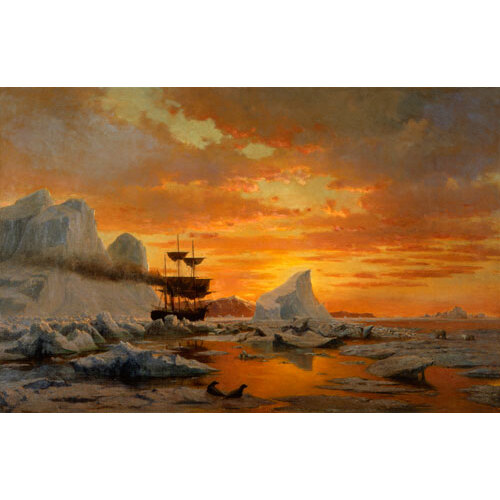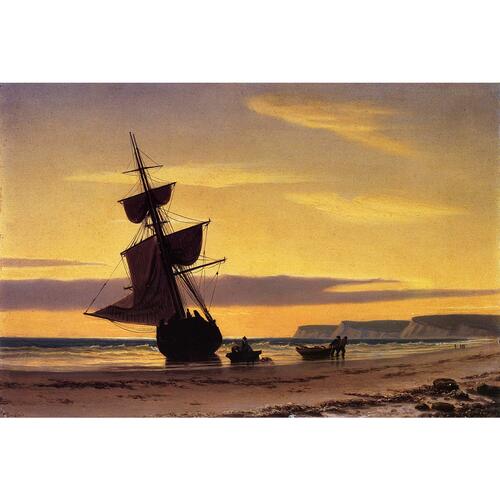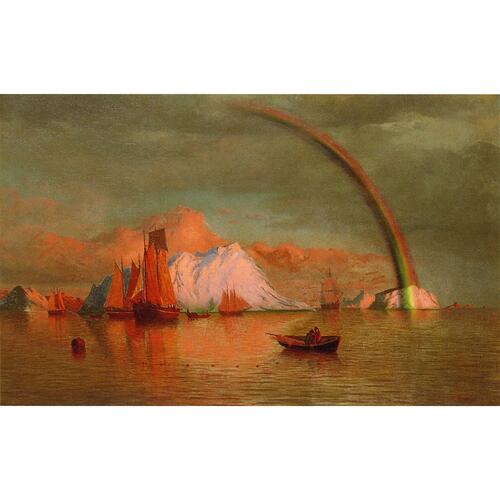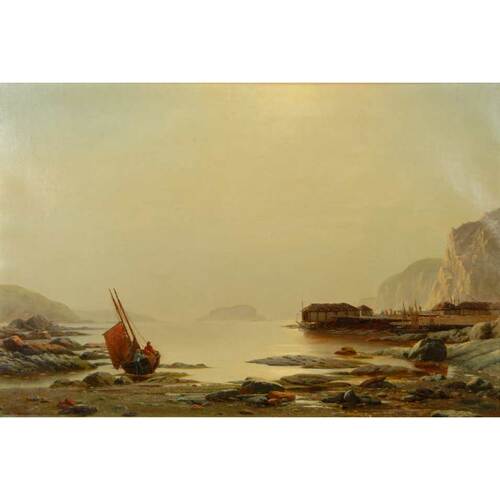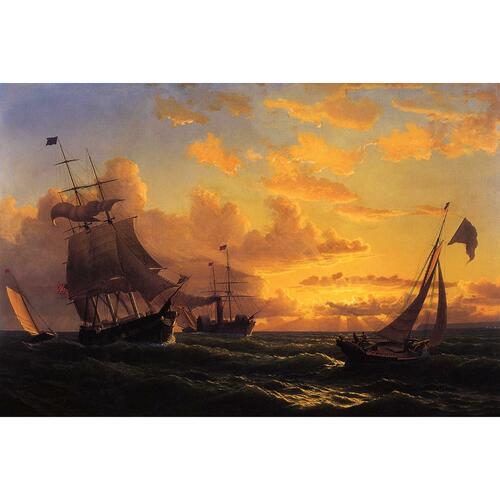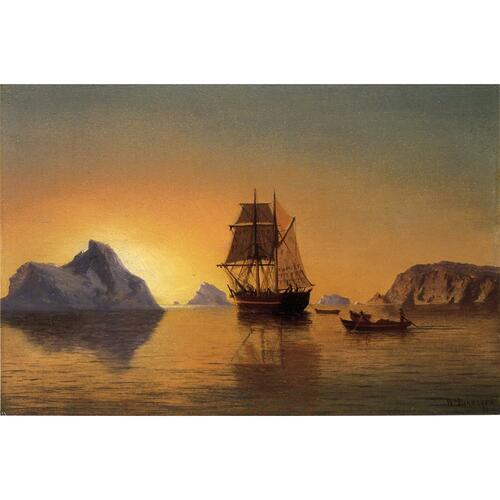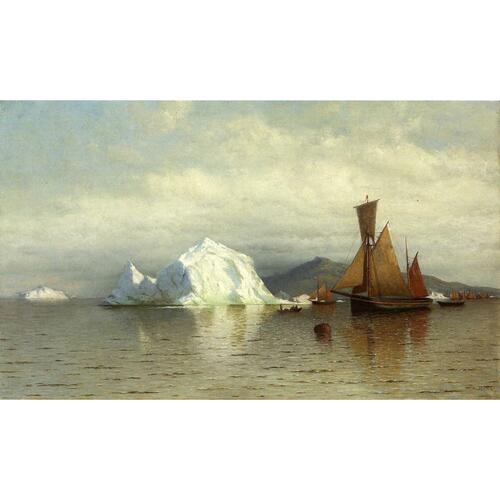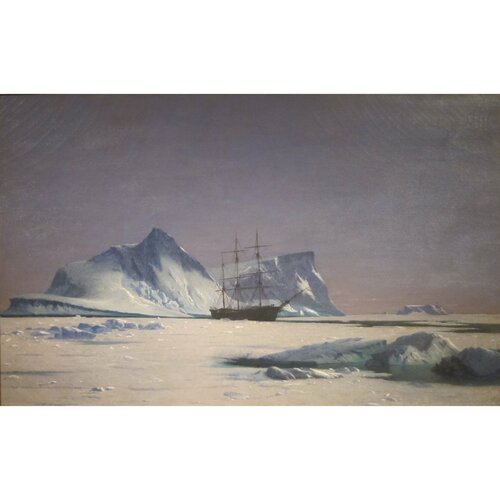![Description English: Coastal Scene Date 1860(1860) Source [1] Author William Bradford (1823-1892)
Original title: Description English: Coastal Scene Date 1860(1860) Source [1] Author William Bradford (1823-1892)](/bioimages/w600.5205.jpg)
Source: Courtesy of Wikimedia Commons
BRADFORD, WILLIAM, painter, photographer, and author; b. 30 April 1823 in Fairhaven, Mass., son of Melvin Bradford and Hannah Kempton; m. Mary Breed in Lynn, Mass., and they had two daughters; d. 25 April 1892 in New York City.
Raised in a Quaker family in Massachusetts, William Bradford showed an early interest in painting. He was, however, prevailed upon by his father, who disapproved of art as a profession, to enter the family retail dry goods business. Bradford none the less spent much time developing his artistic skill and eye by copying from a book of English drawings and sketching in a precise, thin line the ships in the harbours of New Bedford and Lynn. Gradually he broadened his vision to include the coastal scenery. In 1853 he was at last able to devote his time exclusively to painting, and between 1854 and 1857 he made several trips to Labrador. He set up his own studio in Fairhaven in 1855 and accepted commissions for portraits of merchant and whaling vessels. His studio was shared for several years by Dutch marine artist Albert Van Beest, whose European training had a beneficial influence on Bradford’s style, loosening his painstaking line and teaching him the merits of a more fluid, suggestive expression.
Recognition of Bradford beyond his native area came gradually as his interests turned increasingly to portraying the mysteries of the northern ice-choked seas. The disappearance of the 1845 expedition led by popular explorer Sir John Franklin* had sparked tremendous public and artistic interest in the Arctic. Two accounts of searches for Franklin, published in the mid 1850s by American explorer Elisha Kent Kane* with illustrations by James Hamilton, made a profound impression on Bradford, who later wrote: “I was seized with a desire, which had become uncontrollable, to visit the scenes they had described and study Nature under the terrible aspects of the Frigid Zone.” Bradford was probably inspired also by the work of the well-known American artist Frederick Edwin Church, who had accompanied Isaac Israel Hayes* on his 1860–61 search for an open polar sea. With the help of various financial backers, from 1861 to 1867 Bradford himself organized annual voyages along the coasts of Nova Scotia and Labrador for the purpose of painting northern scenery and icebergs. In 1869 he mounted his last and most ambitious expedition, for which he chartered the Scottish steamer Panther. His party of 40 men included Captain John Bartlett, Hayes, a crew of Newfoundlanders, and two photographers, John B. Dunmore and George B. Critcherson. Departing from St John’s on 3 July, they sailed as far north as Baffin Island (N.W.T.) and Melville Bay, Greenland, where as many as 200 icebergs could be sighted at one time. Bradford returned with a collection of photographs and a vast number of sketches of the rugged landscape and the details of Inuit life.
During the early 1870s Bradford travelled with his family to London. He maintained a studio and began a successful second career lecturing on the Arctic. His account of the 1869 journey, accompanied by 130 photographs, was published in London in 1873 as The Arctic regions, a folio-sized limited edition. While in England, he sold several paintings to members of the aristocracy, and came to know Lady Jane Franklin [Griffin*] and Lord Tennyson. His most important achievement was undoubtedly a commission from Queen Victoria; the painting, entitled The “Panther” off the coast of Greenland under the midnight sun, was hung in the library of Windsor Castle.
Bradford returned to North America around 1874, and thereafter limited his travels to the United States. Based in a studio in New York City, he developed a different artistic style, using photographs and pencil sketches from his northern journeys as the source for large compositions in oil. Unfortunately, these works show a return to the tighter line of his earlier days and suffer at times from hot metallic colours and the repetition of imagery. Although his painting lost much of its freshness as distance and time separated the artist from his sources, his career nevertheless continued to be distinguished by an unusual direction and steadfastness; describing Bradford’s patience as “one of his most effective traits as an artist,” art historian Henry Theodore Tuckerman attributed it to the “self-control and calmness” of Quaker life. Bradford’s study of the exotic northern wilderness through the media of both painting and photography combined in a commendable balance the major preoccupations of the 19th century: the pursuit of science, romance, and natural beauty. With these interests and a highly developed artistic skill, William Bradford has left a legacy of glorious landscapes, revealing a sensitive perception of the unique light, strange forms, and surprising colours of the Arctic regions.
William Bradford is the author of The Arctic regions, illustrated with photographs taken on an art expedition to Greenland; with descriptive narrative by the artist (London, 1873). Two unpublished albums of photographs taken by Bradford and his assistants, George B. Critcherson and John B. Dunmore, “Arctic scenes: ice” and “Photographs of Arctic ice,” are preserved in the Prints and Photographs Division of the Library of Congress (Washington).
I. I. Hayes, The open polar sea, a narrative of a voyage of discovery towards the North Pole, in the schooner “United States” (London, 1867). E. K. Kane, Arctic explorations: the second Grinnell expedition in search of Sir John Franklin, 1853, ’54, ’55 . . . (2v., Philadelphia and London, 1856); The U.S. Grinnell expedition in search of Sir John Franklin: a personal narrative (new ed., London and New York, 1854). L. L. Noble, After icebergs with a painter: a summer voyage to Labrador and around Newfoundland (New York, 1861). New-York Times, 26 April 1892. DAB. Clara Erskine Clement [Waters] and Laurence Hutton, Artists of the nineteenth century and their works . . . (2v., Boston and Cambridge, Mass., 1879; repr. St Louis, Mo., 1969). Harper, Early painters and engravers, 42. Constance Martin, James Hamilton: Arctic watercolours (exhibition catalogue, Glenbow Museum, Calgary, 1983). The New-York Historical Society’s dictionary of artists in America, 1564–1860, comp. G. C. Groce and D. H. Wallace (New Haven, Conn., and London, 1957; repr. 1964). H. T. Tuckerman, Book of the artists: American artist life . . . (New York and London, 1867; repr. 1966). John Wilmerding, William Bradford, 1823–1892 (exhibition catalogue, De Cordova Museum, [Lincoln, Mass.], and New Bedford Whaling Museum, [New Bedford, Mass.], [1969?]). J. R. Harper, Painting in Canada, a history ([Toronto], 1966).
Cite This Article
Constance Martin, “BRADFORD, WILLIAM,” in Dictionary of Canadian Biography, vol. 12, University of Toronto/Université Laval, 2003–, accessed April 1, 2025, https://www.biographi.ca/en/bio/bradford_william_12E.html.
The citation above shows the format for footnotes and endnotes according to the Chicago manual of style (16th edition). Information to be used in other citation formats:
| Permalink: | https://www.biographi.ca/en/bio/bradford_william_12E.html |
| Author of Article: | Constance Martin |
| Title of Article: | BRADFORD, WILLIAM |
| Publication Name: | Dictionary of Canadian Biography, vol. 12 |
| Publisher: | University of Toronto/Université Laval |
| Year of revision: | 1990 |
| Access Date: | April 1, 2025 |


